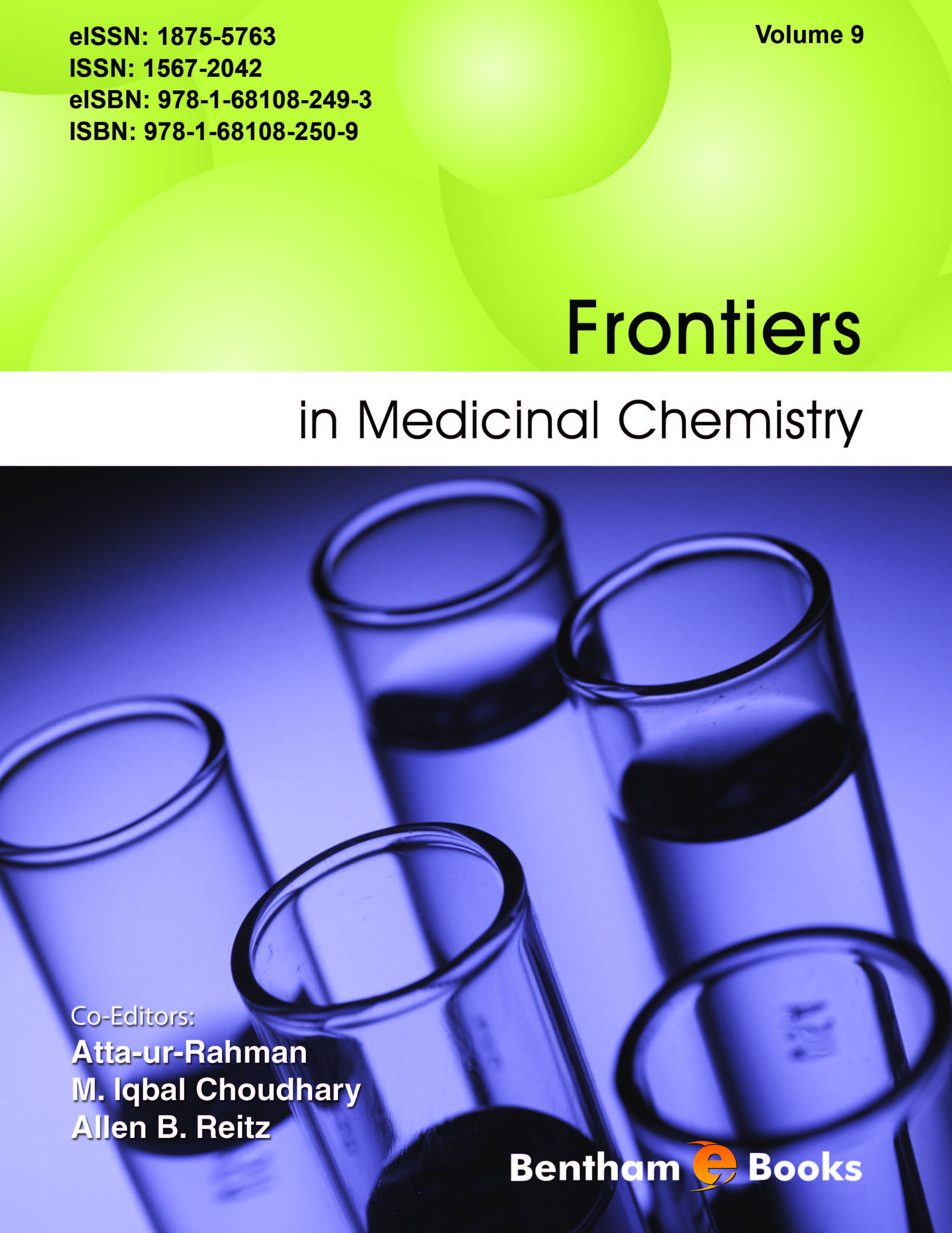Volume 9 of the eBook series “Frontiers in Medicinal Chemistry” is a
compilation of six superbly written reviews on various aspects of medicinal
chemistry, including critical analysis of various drug targets, and understanding of
the manifestations of various types of ligand-receptor interactions. These reviews
provide valuable insights of the chemical, and pharmacological importance of
various classes of chemical compounds for drug discovery against diseases.
In chapter 1 Burnstock covers the involvement of purinergic receptors and
signaling in pain, and other essential cellular functions. Purinergic signaling is an
extracellular signaling process, mediated by purine nucleotides, and nucleosides.
It involves the activation of purinergic receptors in the cell and/or in nearby cells,
thereby regulating diverse cellular functions. There are many different types of
purinergic receptors which mediate in various biological functions. The chapter
highlights the current classification of receptor sub-types for purines and
pyrimidines and recent developments of various classes of compounds as
potential inhibitors of purinergic receptors for the treatment of both visceral and
neuropathic pain have been reviewed.
Santucci et al review the consequence of mitochondrial damage in various
diseases in chapter 2, Mitochondria play an important role in programmed cell
death process (apoptosis). Any mitochondrial malfunction provokes the unregulated
release of cytochrome c and pro-apoptotic factors, which through a
complex cascade, lead to cell death. This review provides an excellent overview
of the key role that mitochondria play in the apoptotic process and ramifications
of mitochondrial damage on this process.
Dipeptidyl peptidase-4 (DPP4) is expressed on the surface of many cell type, and
catalyses the cleavage of X-proline from the N-terminus of polypeptides. Its role
in various physiological functions, such as regulation of the biological activity of
hormones and chemokines, including glucagon-like peptide-1, and glucosedependent
insulinotropic polypeptide has been widely studied in recent years. The
enzyme has also been identified as a valid target for inhibition for the discovery of
drugs against many diseases including diabetes mellitus II. Matteucci and
Giampietro in chapter 3 have contributed a comprehensive review on
physiological roles, and pathological functions of DPP4. Development of various
classes of new inhibitors of DPP4 as potential drugs along with their specificity, risk-benefits of the currently available DPP4 inhibitors and future prospects in this
key field have been discussed.
D’Andrea et al have compiled a systematic review in chapter 4 on the modulation
of angiogenesis by using various classes of small molecules, including peptides.
Angiogenesis has been implicated in many diseases, including cancer. Modulation
of angiogenesis is highly desirable for the treatment of these diseases. The authors
have explained at length the molecular mechanism of the angiogenic cascade,
which involves a balance in pro- and anti-angiogenic factors, selective binding of
these growth factors to cell surface receptors, the resulting signaling to initiate
biochemical pathways, and the corresponding angiogenic response. Many classes
of peptides have been developed with the capacity to target the growth factorreceptor
interface which lead to inhibition of angiogenesis. Pharmacological and
diagnostic applications of these peptides are extensively reviewed with reference
to their possible applications for the treatment of angiogenic related diseases,
including cancers.
Obesity is a major, yet preventable, cause of mortality and morbidity.
Unfortunately the effective treatment for obesity and associated disorders is yet to
be developed. Many of the blockbuster drugs against obesity have been either
withdrawn or find only restricted use due to unwarranted side effects. A
considerable success has be achieved in identifying the molecular mechanisms
involved in energy imbalance leading to obesity. This has opened new vistas for
the development of innovative therapies for the obesity disorders. Chapter 5
contributed by Hruby and Cai is focused on scientific evidences on the
involvement of melanocortins 3 (MC3R) and 4 (MC4R) receptors in energy
balance, feeding behaviors, and many other physiological functions. Their
selective agonists and antagonists, including melanotropin ligands, can modulate
MC3R and MC4R activity, and can thus serve as drugs for the treatment of
feeding disorders. The review discusses various aspects of the topic, including
new directions.
Recent developments in nanotechnology have revolutionized various fields,
including drug delivery. Debbage et al. in chapter 6 have contributed an excellent
review on the discovery and development of diverse array of nanoparticles for
targeted transport of drugs. In recent years, several classes of nanomaterials, made
up of liposomes, synthetic polymers, proteins, dendrimers, fullerenes, etc., have
been developed. Many of them are similar to proteins and other macromolecules which are found inside the living cells, and thus can take advantage of existing
cellular machinery to facilitate the delivery of drugs at the target. Nanoparticles
have the capacity to encapsulate, disperse, absorb, and conjugate drugs that can
lead to enhanced performance in a variety of dosage forms, and improved
pharmacokinetics and pharmcodynamic properties. Based on specific architecture
and basic material, nanoparticle based drugs (“nanomedicines”) can overcome
cellular resistance, rapidly cross cellular barriers, provide enhanced adhesion to
biological surfaces, and transport large payloads of drugs, thereby providing rapid
therapeutic results, and improved bioavailability. The review provides an
excellent overview of the entire field of nanomediciens, including challenges and
opportunities for the future.
At the end we are profoundly grateful to all the contributors for timely completion
of their writing assignments. The present 9th volume of the eBook series is the
result of the efficient management of the entire team of Bentham Science
Publishers, particularly Mr. Omer Shafi (Assistant Manager Publications),
Mr. Shehzad Naqvi (Senior Manager Publications) and the team leader
Mr. Mahmood Alam (Director Publications) who deserve our deepest
appreciation for putting together an excellent treatise of well written articles in an
efficient manner. We are confident that this volume of eBook series will receive
wide appreciation from students, researchers and established scientists.
Atta-ur-Rahman, FRS
Honorary Life Fellow, Kings College
University of Cambridge
UK
Iqbal Choudhary
H.E.J. Research Institute of Chemistry
International Center for Chemical and Biological Sciences
University of Karachi
Pakistan
Allen B. Reitz
Chemical Biology, Institute of Hepatitis and Virus Research
CEO, Fox Chase Chemical Diversity Center, Incorporation
Doylestown, PA 18902,
USA

